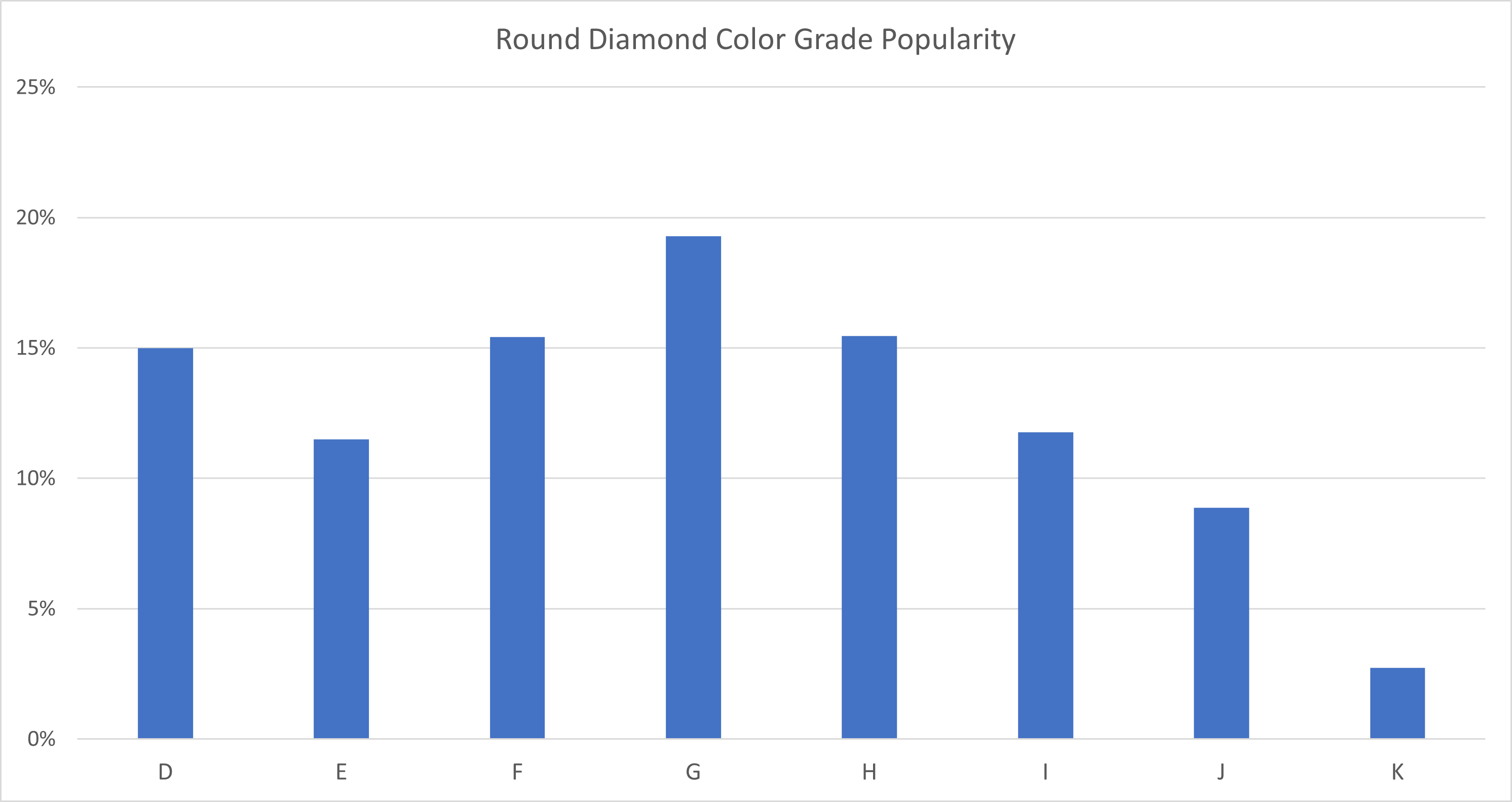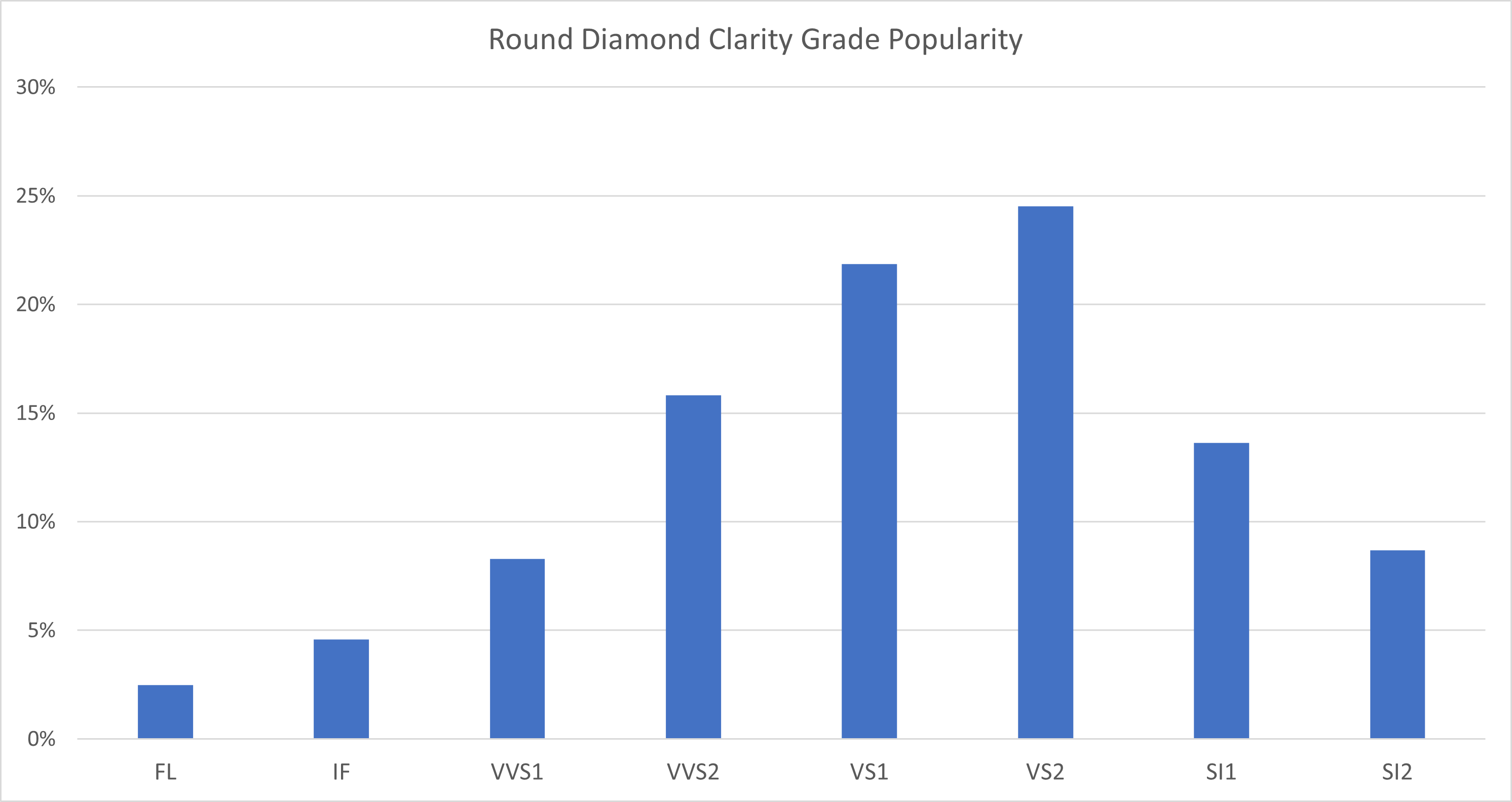January 28th 2022
The Round Cut Diamond Guide
By Devin Jones
Round diamonds are by far the most popular shape for engagement ring diamonds and it's not even close. According to StoneAlgo's internal data, 55% of engagement ring shoppers choose a round cut diamond. But the popularity of round diamonds comes at a price: round is the most expensive diamond shape by carat weight as you can see in the below.
Round cut diamonds typically offer the best sparkle (known as brilliance) of any diamond shaped, thanks to the innovative round brilliant cut design that features 57 facets optimized for light performance (58 if you count the culet). However, cutting a round diamond into this shape is costly as it requires more raw material (diamond rough) to yield a 1 carat round brilliant cut diamond than it does for other diamond shapes. This is the primary reason that round cut diamonds command a significantly higher price than other diamond shapes per carat, as you can see in the table above.
Round Diamond Prices
Round cut diamonds are nearly 40% more expensive than other diamond shapes on average. Diamond prices and the difference in price between round and fancy cuts can vary significantly based on the color and clarity grades of the diamonds, as well as plenty of other factors like polish and symmetry.
Below are the prices for round cut G color, VS2 clarity diamonds of various carat weights based on live prices from July 2022.
| Carat Weight | Price | Price Per Carat |
|---|---|---|
| 0.5 | $1,691 | $3,382 |
| 1 | $8,437 | $8,437 |
| 2 | $31,153 | $15,577 |
| 3 | $68,972 | $22,991 |
- 0.5 carat round cut diamond prices
- 1 carat round cut diamond prices
- 2 carat round cut diamond prices
- 3 carat round cut diamond prices
Ideal Dimensions, Proportions, and Angles for a Round Cut Diamond
Round is the only diamond shape that receives a "cut" grade from the GIA. When it comes to round cut diamonds, it's not worth going down to a lower cut grade than Excellent since the discount for Very Good and Good cut diamonds is small relative to the impact that lower cut quality will have on sparkle and overall appearance. My general advice is that you should always choose excellent cut and symmetry, and you should target excellent polish as well (though this is not as important as the other two grades).
Excellent is the highest cut grade awarded by the GIA, while ideal is the highest grade awarded by the AGS for diamond cut quality. Some online jewelers will generalize both terms as “ideal” – but when it comes to GIA certified diamonds you can chalk this up as “excellent” cut. So which is superior and why? Well, the AGS has higher cut specifications, meaning that the “lowest” ideal cut AGS diamond will typically be better than the “lowest” GIA excellent cut diamond.
Here at StoneAlgo we judge diamonds on the their dimensions in order to calculate our diamond cut score, and round diamonds are pretty tough to judge since there are so many moving parts. Basically, there is a balancing act that goes on between the girdle thickness, table %, depth %, pavilion angle, and crown angle. For a given depth, table, and girdle thickness there are an ideal set of angles that will return light most optimally. Our cut score was designed to simplify this process and guarantee that we find the most well balanced diamonds. Here is a rough idea of the ideal dimensions for a round cut diamond:
- Ideal Table Percentage: 54% - 58%
- Ideal Depth Percentage: 61% - 62.5%
- Ideal Girdle Thickness: Thin - Slightly Thick
- Ideal Pavilion Angle: 40.5 - 40.9 degrees
- Ideal Crown Angle: 33.5 - 36 degrees
- Culet: None or Pointed
As we noted, the ideal dimensions change to balance one another out. For example, a higher pavilion angle will be balanced by a lower crown angle and vice versa. These angles directly affect the depth percentage of the diamond as well. If you want to know exactly how well cut a round diamond is we recommend you use our cut score to ensure you aren’t making a mistake based on incomplete information. If you’d like to dig more into how the ideal dimensions work we recommend checking out the cutting chart guidelines from the AGS here or by reading the Diamond Design book by Marcel Tolkowsky here.
Ideal Crown & Pavilion Angles for Round Cut Diamonds
The sparkle of a round cut diamond is determined by the ability for light that enters the diamond to reflect back out of the top of the diamond. This is achieved thanks to the many facets of the round cut diamond that basically act as tiny mirrors. The optimal proportions and angles for achieving this affect have been widely studied. The results of these studies became the basis of StoneAlgo's propriety diamond cut score. Below are the average StoneAlgo cut scores for various pavilion (y-axis) and crown angles (x-axis).
The ideal crown and pavilion angles for an excellent cut round diamond.
Please note that these ideal angles change depending on table percentage and depth percentage. To calculate a cut score for any GIA certified diamond you can run it through our GIA Check Tool.
Best Color Grades for Round Cut Diamonds
When it comes to color and clarity, round diamonds finally offer a way to save a little money versus the less expensive fancy shapes. That’s because round cut diamonds hide both color saturation and imperfections better than other diamond shapes. This means, while you may want to consider a colorless princess cut diamond, you can certainly go for an H or even an I color round cut diamond without noticing any yellow tint. If you're shopping for a yellow gold or rose gold setting, you can go even lower to a J or K color grade since these darker settings actually help to hide the natural color of the diamond.
Based on internal data from our diamond search engine, the most popular color grade for round cut diamonds is G color. Here are the most popular color grades for round cut diamonds.
The most popular color grades for round cut diamonds.
Round Diamond Clarity Recommendations
Clarity is the toughest aspect of a diamond to judge simply based on a diamond’s grading certificate alone. Two diamonds of the exact same size and clarity grade can look totally different depending on the types of inclusions in the diamond and where they are located. Generally speaking, these differences in appearance are not relevant in the better clarity grades like FL, IF, VVS1, VVS2, VS1, and even VS2 clarity – though occasionally a VS2 clarity will not be as eye clean as you may expect it to be.
Eye clean diamonds are diamonds that don't have any visible flaws without the aid of magnification. On the flip side, SI1 diamonds can appear totally eye clean when they have inclusions in a certain location where it is less visible. Eye clean means that a diamond looks flawless without the aid of magnification from a jewelers loupe or microscopic lens. Here’s an example of a 1 carat F color SI1 clarity diamond that doesn’t appear to be eye clean (notice the black speckles across the top right corner).

Compare the above image to the below picture of another 1 carat F color (but this time eye clean) SI1 – the diamond received an SI1 grade due to some internal graining not shown as you can see by clicking the diamond and viewing its GIA certificate. This type of inclusion is tough to see even under magnification and is a good example of why eye clean SI1 diamonds are the most sought after when buyers are trying to stretch their engagement ring budget. We would note, however, that eye clean SI1’s typically cost about the same as VS2 clarity diamonds and sometimes even more – don’t simply trust that due to the grade you are getting a good deal!

The worst place for an inclusion is in the center/top of the diamond because this is the most visible location. The below is a diamond that has a large black inclusion right in the top center area – more visible in the video on James Allen’s site but you can clearly make it out below as well. If an inclusion appears off to the side of the diamond it can sometimes be covered by one of the prongs on the ring setting and any skilled jeweler will look for the opportunity to do so when setting a stone. We wouldn’t recommend you pay more just to go up in clarity if you can’t see a real, physical difference when you look at the diamond at it’s normal size (most images/videos online are zoomed in at least 10x – you can zoom out to get a better idea of how the diamond will look on a hand).

According to data from our diamond search engine, the most popular clarity grade for round cut diamonds is VS2 clarity.
The most popular clarity grades for round cut diamonds.
Round Diamond Fluorescence Recommendations
Diamond fluorescence produces a glowing property in some diamonds when they are exposed to ultraviolet light. To give an example of how prevalent fluorescence is in the diamond market, this affect is present in about 35% of the diamond inventory available at Blue Nile currently. Fluorescence is not necessarily a good thing or a bad thing, but like most things in life it’s good in moderation or in certain situations.
For example, if you are buying a colorless diamond (D – E), then fluorescence may not be a good thing. But for diamonds graded I – K and lower, faint or even medium fluorescence can actually help the diamond appear whiter. Strong fluorescence is typically not recommended as it can make the diamond look hazy – so we’d recommend you stick with faint or none to be safe. You may have seen the designation negligible fluorescence which is the AGS grading equivalent to the GIA’s “none” qualification – representing diamonds that do not exhibit fluorescent properties.



